Erebus and Terror - John Franklin
North-West
Passage - Timeline
What started as a prestigious expedition led by a popular hero to solve a centuries old problem and bring great riches, led to the disappearance of two proven ships and 129 men. "Going to look for Franklin" became a euphemism for a generation of adventurers. Slowly, after nearly a decade the story came out, it would be 33 years before it ran its full course.
John Franklin North-West Passage - the story | Franklin North West Passage Map | Erebus and Terror in Antarctica
The Cast - The year is 1845, these are the main characters in the story
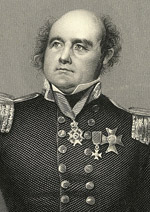
Sir John Franklin
Leader of the expedition, Captain of the Erebus
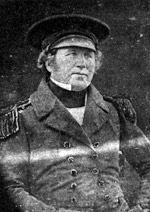
Francis Crozier
Captain of theTerror

Lady Jane Franklin
Wife of Sir John Franklin
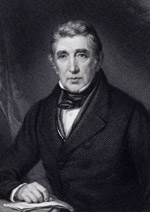
John Barrow
Instrumental in mounting the expedition
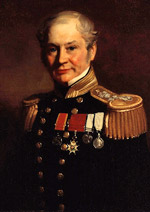
Sir Edward Belcher
In command of five ships sent in 1852 to search for Franklin
-sm.jpg)
John Rae
Explorer who discovered the fate of the expedition in 1854, initially disbelieved
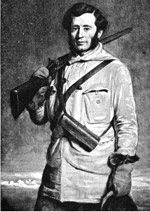
Leopold McClintock
Leader of last official British search, in 1857 found the only written message from Franklin expedition
"Nothing is found" - relates to finding nothing of the Franklin Expedition which was (at least publically) the purpose of the voyages. A great deal of exploration, surveying and mapping was carried out during these rescue missions which ultimately proved very valuable.
Ship names - in italics RM - rescue mission
| What the world knew | Year | What was happening in the Arctic |
|
Popular hero
Sir John Franklin leads an expedition to find
the fabled North West Passage route from Europe
to the Orient. The chances of
success are greater than they have ever been. Letters arrive home in England brought by a supply ship that accompanied the two expedition ships to Greenland before returning. All is well and the crews are in good spirits. John Barrow retires from the Admiralty in January, the Franklin Expedition will be the last he sends out. |
1845 (year 1) |
19th May HMS Erebus
and HMS Terror
leave Britain with a supply
ship for Greenland via the Orkney Islands. The
supply ship returns to Britain with letters.
Erebus and Terror continue across Baffin Bay. 26th July, Erebus and Terror are seen by two whaling ships in Baffin Bay, it is the last contact they will have with the outside world. The first winter is passed iced in at Beechey Island, 1845-1846 |
|
No news |
1846 (year 2) |
All are buried on Beechey Island. In the summer months, the Erebus and Terror sail south down the Peel Channel which is unusually ice free this year, more commonly it is ice choked which is what stopped would-be rescue missions from being able to investigate. Both ships overwinter 1846-47 to the north of King William Island about 350 miles (560 km) further south than the previous winter. The ships were iced in on the 12th of September 1846. |
|
9th February, John Ross approaches the
Admiralty in London with plans for a rescue
mission when there is no news of the
expedition, he is rejected as is an attempt
by a Dr. King. November, the Admiralty Board accept that a rescue mission is required, they appoint James Ross to lead it leaving the following spring. |
1847 (year 3) |
Winter 1846-7, Inuit
testimony records that the Terror
is heaved onto her beam ends (on her side)
by the ice. All crew winter on the
Erebus. 28th May a note found from this date (the only note ever found) says "All Well". The death toll to date seems to be 3 men. 11th June, Sir John Franklin dies of natural causes, the total death toll at this time was 24 men. |
| What the world knew | Year | What was happening in the Arctic |
|
RM
- James Clark Ross, (HMS
Enterprise, HMS Investigator)
from the east, only reach as far as Somerset
Island due to ice, nothing is found. RM - Rae / Richardson Arctic Expedition overland from the Mackenzie River(center of the Canadian Arctic) and along the coast, nothing is found. RM - HMS Plover, HMS Herald from the Bering Strait in the west. William Pullen reaches Mackenzie River by whaleboat, nothing is found. |
1848 (year 4) |
Winter 1847-48, the dead
are placed in the abandoned Terror
which becomes a mortuary ship - Inuit
testimony. 22nd April, Erebus and Terror are deserted having been "beset" (frozen into the ice without release) for around 19 months during which time they drifted 9 miles. The ships later sink after being crushed in the ice. 25th April, Captains Crozier and Fitzjames make a written record (around the margin of the previous one nearly a year earlier). They say they intend to walk to the Back's Fish River setting off the next day the 26th. There are 105 survivors at this time. |
| John Rae sets out with 7 men in June after overwintering at "Fort Confidence". Nothing is found or heard at this time. Rae remains in the north surveying and searching on behalf of the Hudson's Bay Company for several more years. |
1849 (year 5) |
Inuit testimony tells that
the Erebus was occupied again in spring 1849
with the Terror still on her beam ends. The
crews had started to fragment into smaller
parties now, in part according to strength
and health. From 1849 to 1850, the surviving crew hunted birds and caribou in the summer and seals in the winter. They had taken supplies for 3 years which were now exhausted. Good relations seem to have developed between the reaming crew and local Inuit with at least one very successful joint caribou hunt. Captain Crozier is thought to have died sometime during 1849-50 and to have been given a military burial as witnessed by some Inuit. |
|
RM
- Richard Collinson (HMS
Enterprise), Robert McClure
(HMS Investigator)
from the Bering Strait. McClure frozen
in at Banks Island, when rescued becomes first
man to cross the northwest passage. Collinson
reaches Coronation Gulf, furthest east of any
ship. Nothing is found. RM - Horatio Austin (HMS Resolute), Erasmus Ommanney (HMS Assistance), from the east plus 2 steam tenders, Pioneer and Intrepid. Ommanney finds Franklin's Beechey Island camp. The ships winter near to Beechey Island, are frozen in and in spring send out sledge expeditions in all directions. They leave the Arctic before winter in 1851. RM - Charles Forsyth (Prince Albert) from the east, financed by Lady Franklin and public subscription. On learning of the Beechey Island camp Forsyth races back to tell Lady Franklin so ignoring her instructions to explore further much to her disappointment. Nothing is found. RM - William Penny Admiralty backed expedition (Lady Franklin and Sophia) from the east. The ships winter at Assistance Harbour, Cornwallis Island, near to Beechey Island, frozen into the ice. In spring parties are sent out by sledge and boat. After quarreling with Austin (on the Resolute) they return home in September 1851. Nothing is found. RM - John Ross (schooner Felix) from the east. Wintered near to Beechey Island, frozen into the ice. Left the Arctic in the summer of 1851. RM - Edwin de Haven (USS Rescue, USS Advance) from the east, the First Grinnell Expedition, financed by Henry Grinnell and the American government. The ships winter in Wellington's Strait frozen into and drifting with the winter ice. They leave the Arctic before winter in 1851. Findings at Beechey Island and Cape Riley of winter camps. |
1850 (year 6) |
The crew hunting in the winter left a trail
of sites where they cooked seal meat over
blubber fires. The fat from the fires soaked
into the ground and can still be detected
today. At this time, some Inuit hunters see 40 white men dragging a boat on a sledge, the Inuit sold the men a seal for food. This information reported to John Rae in 1853. The Inuit also tell of a later date in the same season of many dead men and of signs of cannibalism which are later proven by forensic studies. John Rae's report of this meeting in a letter sent to the Admiralty in 1854 Around 1850, the still intact Erebus now released from the ice was taken south with a very small crew in the command of a physically large officer, possibly Captain Fitzjames, or Lieutenant Fairholme. This man died shortly after arrival in Wilmot and Compton Bay on the west side of the Adelaide Peninsula as described by Inuit who found him in the great cabin. The remaining crew sought out animals to hunt in the summer both here and by boat to the west. There are several accounts of "white men" who tried to hunt but died. December 7th. The threat of damage by ice means that the crew of the Rescue are taken on board the Advance (both from the first Grinnell expedition) just 50 yards away. |
| What the world knew | Year | What was happening in the Arctic |
| RM - William Kennedy (Prince Albert again) Lady Franklin's second private expedition from the east. Proves Somerset Island is an island. After one winter in the ice returns to Britain in October 1852. Nothing is found. |
1851 (year 7) |
In the summer of 1851 or 1852
the Inuit report that there are four
remaining survivors, being the best of the
hunters accompanied by a dog used to locate
seal holes in the ice. They set out for the
west and are not heard of again. This is thought to be when the last survivors from the Franklin Expedition finally died. In March the Rescue is taken into a dry-dock carved from surrounding ice and refitted to repair the winter damage. Against the odds the crew are able to return to the Rescue which looked like it would be lost during the winter. Breaking out of the ice on the 5th of June, they resumed their search before returning to New York by the 30th of September. |
|
RM
- Edward Augustus Inglefield (Isabel
- Lady Franklin's private
steamer) in northern Baffin Bay, one
summer only. Nothing is found. RM - Edward Belcher with five ships from the east, four from the returning Austin expedition of 1850, HMS Resolute, HMS Assistance, steam tenders, Pioneer and Intrepid. A fifth ship the supply vessel North Star will stay at Beechey Island as a depot ship. Four of the five ships are abandoned in the ice, only the North Star returns. Nothing is found. RM - Boat expedition up the Wellington Channel under the command of R. M'Cormick, R.N., in HMB Forlorn Hope. Nothing is found. |
1852 (year 8) |
The abandoned Erebus is discovered intact by the Inuit and is known as "The Utjulik ship". It is used for salvaged materials for at least eight years before drifting ashore and becoming at least submerged. |
|
John Rae still
travelling overland since 1848 learns where
Franklin lost his ship from
a group of Inuit he meets, their story describes
events in 1849/50. RM - Dr. Elisha Kane (USS Advance) from the east, the Second Grinnell Expedition, financed by Henry Grinnell and others. Nothing is found. Almost RM - William Kennedy, Lady Franklin's attempted second private expedition. Aborted when the crew mutinied in Valparaiso, Chile. |
1853 (year 9) |
HMS Investigator
abandoned in Mercy Bay on the 3rd of June where
it had been frozen for three years without release.
It had sailed into the Arctic in 1850 from the
Bering Strait. The ship then became a source
of iron and copper for the Inuit after later
becoming beached. It was last reported as being
seen in 1910, the submerged wreckage was found
in 2010 in 11m of water 150m offshore. McClure and the crew of HMS Investigator are rescued by Kellett of the Resolute after being ordered to abandon the ship, they had been on reduced rations for over a year. 21st August Breadalbane, a supply ship for Belchers 1852 expedition is crushed by ice and sinks near Beechey Island. The crew of 21 were rescued by HMS Pheonix. The most northern ship wreck known (500 miles above the Arctic Circle) and best preserved wooden ship ever found when detected in 1980. |
| What the world knew | Year | What was happening in the Arctic |
| John Rae's story told to him by Inuit reaches London and is published on the 23rd of October. The news is so shocking he is largely disbelieved by the public by Lady Franklin and by the establishment. As the bearer of unwelcome bad news, he is shunned. His report is true however and is eventually accepted. |
1854 (year 10) |
April, Belcher orders Kellett to abandon
Resolute.
The ship is prepared as for winter. The crews
of the Intrepid, Resolute and Investigator
march to Beechey Island. 22nd May. Thomas Morgan of the HMS Investigator dies aboard HMS North Star, buried on Beechey Island. Belchers ships Assistance and Pioneer abandoned, the crews march to Beechey Island. The crews of the five abandoned ships board the North Star to make for home. Two relief ships HMS Phoenix and HMS Talbot arrive as she is about to sail and help take on the extra men, they leave Beechey Island on the 29th of August. |
| RM - Land based expedition - Anderson and Stewart descend the Back River and find relics in Chantry Inlet. |
1855 (year 11) |
20th May USS Advance is abandoned
by Kane and the Second Grinnell Expedition
to avoid the possibility of a third winter frozen
into the ice, the remaining crew reach New York
on October the 11th. 10th September American whaler George Henry finds the Resolute in good order 1,200 miles (1,900 km) from where she was abandoned 19 months previously. She is sailed to Connecticut with a small crew. |
| The refitted Resolute was presented to Queen Victoria. When the ship was eventually broken up in 1879 a desk made from the ships timbers was presented to the then American president as thanks for the return of the ship. This "Resolute desk" has been used by most American presidents in the oval office ever since. |
1856 (year 12) |
|
| RM - McClintock sails on the Fox paid for by money raised by Lady Franklin. |
1857 (year 13) |
|
| What the world knew | Year | What was happening in the Arctic |
| McClintock arrives back in London on the 21st of September with news of his findings and the only written records of Franklin's Lost Expedition from 1847 and 1848. |
1859 (year 15) |
McClintock on the Fox finds relics at King William Island, a ship's boat on runners with two corpses and the only written record of the expedition. McClintock is told of the fate of the Erebus and Terror and their crews by Inuit who had last visited the Erebus the previous summer, though these details are dismissed on his return to London, at least in part because the reports of cannibalism. |
| RM - Charles Francis Hall privately funded overland expeditions, initially driven by the idea that survivors of Franklin's Expedition might be living with Eskimos. Finds relics and skeletons at King William Island. |
1869 (year 25) |
|
| Allen Young (steam yacht Pandora) funded by Young, Lady Franklin and others. Intended to search for Franklin records and attempt the north west passage. Blocked at Peel Sound, returned to Britain in October. |
1875 (year 31) |
|
| Frederick Schwatka - American Geographical Society expedition to King William Island to look for written records. |
1878 (year 34) |
Many relics were found, several graves identified
along with exposed corpses that were given proper
burial. The
main conclusion was that no further records
from Franklin's Expedition had survived.
This signaled the end of Franklin related search
or rescue missions, 31 years after the first. In 2014 the Erebus is located in an area where she sunk as described by the Inuit. |
John Franklin North-West Passage - pictures and story | Franklin North West Passage Map
